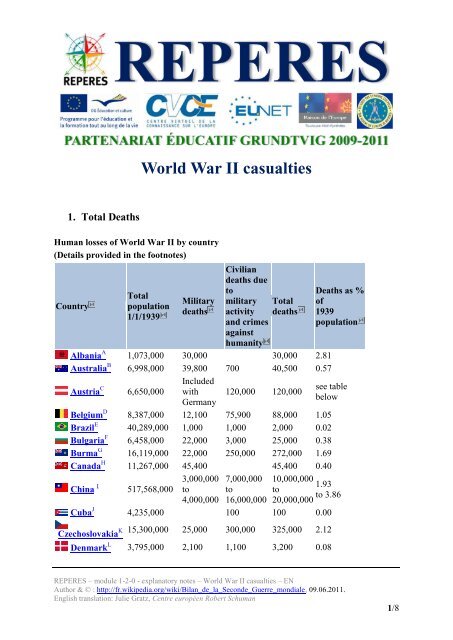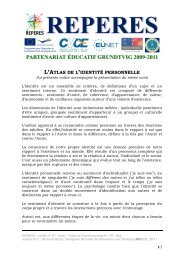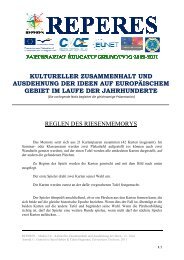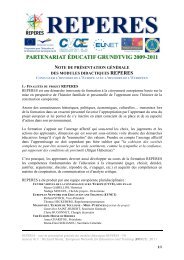World War II casualties - Centre européen Robert Schuman
World War II casualties - Centre européen Robert Schuman
World War II casualties - Centre européen Robert Schuman
Create successful ePaper yourself
Turn your PDF publications into a flip-book with our unique Google optimized e-Paper software.
<strong>World</strong> <strong>War</strong> <strong>II</strong> <strong>casualties</strong><br />
1. Total Deaths<br />
Human losses of <strong>World</strong> <strong>War</strong> <strong>II</strong> by country<br />
(Details provided in the footnotes)<br />
Country<br />
Total<br />
population<br />
1/1/1939<br />
Military<br />
deaths<br />
Civilian<br />
deaths due<br />
to<br />
military Total<br />
activity deaths<br />
and crimes<br />
against<br />
humanity<br />
Albania A 1,073,000 30,000 30,000 2.81<br />
Australia B 6,998,000 39,800 700 40,500 0.57<br />
Austria C 6,650,000<br />
Included<br />
with<br />
Germany<br />
120,000 120,000<br />
Deaths as %<br />
of<br />
1939<br />
population<br />
see table<br />
below<br />
Belgium D 8,387,000 12,100 75,900 88,000 1.05<br />
Brazil E 40,289,000 1,000 1,000 2,000 0.02<br />
Bulgaria F 6,458,000 22,000 3,000 25,000 0.38<br />
Burma G 16,119,000 22,000 250,000 272,000 1.69<br />
Canada H 11,267,000 45,400 45,400 0.40<br />
China I 517,568,000<br />
3,000,000<br />
to<br />
4,000,000<br />
7,000,000<br />
to<br />
16,000,000<br />
10,000,000<br />
to<br />
20,000,000<br />
1.93<br />
to 3.86<br />
Cuba J 4,235,000 100 100 0.00<br />
K<br />
Czechoslovakia<br />
15,300,000 25,000 300,000 325,000 2.12<br />
Denmark L 3,795,000 2,100 1,100 3,200 0.08<br />
REPERES – module 1-2-0 - explanatory notes – <strong>World</strong> <strong>War</strong> <strong>II</strong> <strong>casualties</strong> – EN<br />
Author & © : http://fr.wikipedia.org/wiki/Bilan_de_la_Seconde_Guerre_mondiale, 09.06.2011.<br />
English translation: Julie Gratz, <strong>Centre</strong> européen <strong>Robert</strong> <strong>Schuman</strong><br />
1/8
Dutch East<br />
Indies M 69,435,000<br />
3,000,000<br />
to<br />
4,000,000<br />
3,000,000<br />
to<br />
4,000,000<br />
4.3<br />
to 5.76<br />
Estonia<br />
(within 1939 1,122,000 50,000 50,000 4.44<br />
borders) N<br />
Ethiopia O 17,700,000 5,000 95,000 100,000 0.6<br />
Finland P 3,700,000 95,000 2,000 97,000 2.62<br />
France Q 41,700,000 217,600 350,000 567,600 1.35<br />
French<br />
Indochina R 24,600,000<br />
Germany S 69,850,000 5,530,000<br />
Greece T 7,222,000<br />
20,000<br />
to 35,100<br />
1,000,000<br />
to<br />
1,500,000<br />
1,100,000<br />
to<br />
3,150,000<br />
300,000<br />
to 770,000<br />
1,000,000<br />
to<br />
1,500,000<br />
6,630,000<br />
to<br />
8,680,000<br />
320,000<br />
to 805,100<br />
4.07<br />
to 6.1<br />
see table<br />
below<br />
4.44<br />
to 11.15<br />
Hungary U 9,129,000 300,000 280,000 580,000 6.35<br />
Iceland V 119,000 200 200 0.17<br />
India<br />
(British) W 378,000,000 78,100<br />
1,500,000<br />
to<br />
2,500,000<br />
1,578,100<br />
to<br />
2,578,100<br />
0.42<br />
to 0.68<br />
Iran X 14,340,000 200 200 0.00<br />
Iraq' Y 3,698,000 500 500 0.01<br />
Ireland Z 2,960,000 200 200 0.00<br />
Italy AA 44,394,000 301,400 155,600 457,000 1.03<br />
Japan AB 71,380,000 2,120,000<br />
Korea AC 23,400,000<br />
500,000<br />
to<br />
1,000,000<br />
378,000<br />
to 483,000<br />
2,620,000<br />
to<br />
3,120,000<br />
378,000<br />
to 483,000<br />
3.67<br />
to 4.37<br />
1.6<br />
to 2.06<br />
Latvia (within<br />
1939 borders) AD 1,951,000 230,000 230,000 11.78<br />
Lithuania<br />
(within 1939 2,442,000 350,000 350,000 14.33<br />
borders) AE<br />
AF<br />
Luxembourg<br />
295,000 2,000 2,000 0.68<br />
Malaya AG 4,391,000 100,000 100,000 2.28<br />
REPERES – module 1-2-0 - explanatory notes – <strong>World</strong> <strong>War</strong> <strong>II</strong> <strong>casualties</strong> – EN<br />
Author & © : http://fr.wikipedia.org/wiki/Bilan_de_la_Seconde_Guerre_mondiale, 09.06.2011.<br />
English translation: Julie Gratz, <strong>Centre</strong> européen <strong>Robert</strong> <strong>Schuman</strong><br />
2/8
Malta AH 269,000 1,500 1,500 0.56<br />
Mexico AI 19,320,000 100 100 0.00<br />
Mongolia AJ 819,000 300 300 0.04<br />
Nauru AK 3,400 500 500 14.7<br />
Nepal BG 6,000,000<br />
8,900 with<br />
Nepalese<br />
& British<br />
Indian<br />
Armies<br />
8,900 .01<br />
AL<br />
Netherlands<br />
8,729,000 17,000 284,000 301,000 3.45<br />
included<br />
Newfoundland AM 300,000 with the 100 100 0.03<br />
U.K.<br />
New<br />
Zealand AN 1,629,000 11,900 11,900 0.73<br />
Norway AO 2,945,000 3,000 6,500 9,500 0.32<br />
Papua and<br />
New Guinea AP 1,292,000 15,000 15,000 1.17<br />
Philippines AQ 16,000,000 57,000<br />
Poland (within<br />
1939 borders) AR 34,849,000 240,000<br />
Portuguese<br />
Timor AS 500,000<br />
500,000<br />
to<br />
1,000,000<br />
5,380,000<br />
to<br />
5,580,000<br />
40,000<br />
to 70,000<br />
557,000<br />
to<br />
1,057,000<br />
5,620,000<br />
to<br />
5,820,000<br />
40,000<br />
to 70,000<br />
3.48<br />
to 6.6<br />
16.1<br />
to 16.7<br />
8.00<br />
to 14.00<br />
Romania<br />
(within 1939 19,934,000 300,000 500,000 800,000 4.01<br />
borders) AT<br />
Ruanda-<br />
0 to 0 to 0.00to<br />
Urundi AU 4,200,000<br />
300,000 300,000 7.1%<br />
Singapore AV 728,000 50,000 50,000 6.87<br />
South<br />
Africa AW 10,160,000 11,900 11,900 0.12<br />
South Pacific<br />
Mandate AX 1,900,000 57,000 57,000 3.00<br />
Soviet Union<br />
(see table below)<br />
AY<br />
168,524,000<br />
8,800,000 14,600,000<br />
to to<br />
10,700,000 12,700,000<br />
23,400,000 13.88<br />
REPERES – module 1-2-0 - explanatory notes – <strong>World</strong> <strong>War</strong> <strong>II</strong> <strong>casualties</strong> – EN<br />
Author & © : http://fr.wikipedia.org/wiki/Bilan_de_la_Seconde_Guerre_mondiale, 09.06.2011.<br />
English translation: Julie Gratz, <strong>Centre</strong> européen <strong>Robert</strong> <strong>Schuman</strong><br />
3/8
Spain AZ 25,637,000<br />
Included<br />
with the<br />
German<br />
Army<br />
Sweden BA 6,341,000 600 600 0.01<br />
Switzerland BB 4,210,000 100 100 0.00<br />
Thailand BC 15,023,000 5,600 2,000 7,600 0.04<br />
United<br />
Kingdom BD 47,760,000 383,800 67,100 450,900 0.94<br />
United<br />
States BE 131,028,000 416,800 1,700 418,500 0.32<br />
Yugoslavia BF 15,400,000 446,000 581,000 1,027,000 6.67<br />
Totals 1,978,167,400<br />
22,572,400 37,585,300<br />
to to<br />
25,487,500 55,207,000<br />
62,171,400<br />
3.17<br />
to<br />
to 4.00<br />
78,511,500<br />
<strong>World</strong> <strong>War</strong> <strong>II</strong> Deaths :<br />
Military and civilian deaths during <strong>World</strong> <strong>War</strong> <strong>II</strong> for the Allied and the Axis Powers.<br />
REPERES – module 1-2-0 - explanatory notes – <strong>World</strong> <strong>War</strong> <strong>II</strong> <strong>casualties</strong> – EN<br />
Author & © : http://fr.wikipedia.org/wiki/Bilan_de_la_Seconde_Guerre_mondiale, 09.06.2011.<br />
English translation: Julie Gratz, <strong>Centre</strong> européen <strong>Robert</strong> <strong>Schuman</strong><br />
4/8
In 1945, many regions were destroyed in Europe and thousand millions of people were killed<br />
or injured. Only neutral countries were not too much affected by the theaters or events of<br />
<strong>World</strong> <strong>War</strong> <strong>II</strong>. Estimates for the total <strong>casualties</strong> of the war range from 50 million to 60<br />
million, millions of people injured, 30 millions of civilians displaced awaiting repatriation,<br />
especially in Eastern Europe. <strong>World</strong> <strong>War</strong> <strong>II</strong> was the deadliest military conflict in history.<br />
Nearly 45 millions of civilians were killed fighting or after bombings and the number of<br />
civilians killed is superior to the number of soldiers killed.<br />
Some populations were almost decimated (deliberate genocide of around six million Jews<br />
during The Holocaust) and others are killed. including the systematic Poland lost nearly 15%<br />
of its population.<br />
An estimated 11 million civilians died as a direct or indirect result of Nazi ideological<br />
policies.<br />
2. Military <strong>casualties</strong><br />
The Soviet Union also suffered unprecedented <strong>casualties</strong> - the total deaths resulting from the<br />
war amounted to 53%, 31% for the Wehrmacht, 1.8% for the United Kingdom, 1.4% for<br />
France and 1.3% for the USA. In total, an estimated 17 877 000 militaries were killed on the<br />
battlefields in Europe with losses amounting to 10 774 000 men for the Allies and 7 103 000<br />
for the Axis powers. The Red army losses of men account for 53% of the total number of<br />
European military <strong>casualties</strong>, Wehrmacht, United Kingdom, France and North-American<br />
army's military <strong>casualties</strong> respectively accounting for 31%, 1,8%, 1,4% and 1,3%. The Soviet<br />
Union miliatary <strong>casualties</strong> account for 88% of the total Allied losses in Europe (United<br />
Kingdom 3%, France 2.3% and United States 2.2%). The total military losses for Germany<br />
and the Soviet Union alone account for 84% of the overall European losses. The military<br />
<strong>casualties</strong> of the German-Russian conflict alone amount to 13 876 400, representing 78% of<br />
the total number of European military casualities.<br />
3. Material damages<br />
Nazis and Allied bombings had wrecked serious material damages in some citites: Berlin and<br />
<strong>War</strong>shaw were almost entirely destroyed. The bombing of Dresden on 13 February 1945<br />
killed approximately 135 000 people. Several areas in London and Rotterdam had been<br />
severely damaged and needed to be totally reconstructed. Millions of people had been made<br />
homeless. Many of the continent's greatest cities, including Hambourg, Stalingrad, Leningrad,<br />
Sébastopol, Kiev, Kharkov, Budapest, lay in ruins.<br />
REPERES – module 1-2-0 - explanatory notes – <strong>World</strong> <strong>War</strong> <strong>II</strong> <strong>casualties</strong> – EN<br />
Author & © : http://fr.wikipedia.org/wiki/Bilan_de_la_Seconde_Guerre_mondiale, 09.06.2011.<br />
English translation: Julie Gratz, <strong>Centre</strong> européen <strong>Robert</strong> <strong>Schuman</strong><br />
5/8
The Western Allies bombed many locations in France. The total number of houses completely<br />
destroyed by the bombings was nearly of 300,000. The bombings destroyed 100 % of the city<br />
of Saint-Nazaire, and partly Le Havre , Caen, Brest, Lorient, Cherbourg, Évreux, Saint-Malo,<br />
Rouen. In France, the financial reparations cost 4 billions 900 millions of francs.<br />
Especially damaged were the transportation and production infrastructures, as railways,<br />
bridges, and roads which had all been heavily targeted by air strikes, while much merchant<br />
shipping had been sunk. The destruction of transportation left the small towns and villages in<br />
Western Europe economically isolated.<br />
A far as it concerns Europe, the Nazis used food as a weapon in occupied countries, stealing<br />
goods and causing starvation. The shortage of food was one of the most acute problems. Food<br />
rationing lasted after that Germany surrendered on 8 May 1945 (in France 200g of bread per<br />
day and less than 200g of meat per week). Towards the end of <strong>World</strong> <strong>War</strong> <strong>II</strong> (1944), the<br />
Dutch famine took place in the German-occupied part of the Netherlands. The overall<br />
economy was greatly affected by the shortage of coal, aggravated by the cold winter of 1946–<br />
1947: homes went unheated and hundreds froze to death. 100 millions of European had to live<br />
with less than 1500 kilocalories per day. According to Alan S. Milward,the situation was<br />
especially bad in Germany where in 1946-1947 the average kilocalorie intake per day and per<br />
inhabitant was only 1,800, an amount insufficient for long-term health.<br />
4. Psychological effects<br />
Every families of victims were profoundly shocked by this deadly war. Besides, the persons<br />
who survived in the concentration camps could never lived ‘like before’. Traumatising<br />
memories haunted them nights and days.<br />
5. Economic situation<br />
In 1947, the levels of production were inferior to those before the war: agricultural production<br />
was 83% of 1938 levels, industrial production was 88%, and exports only 59%. This situation<br />
was due to the lack of work force, the decreasing productivity of work caused by food<br />
shortages, robberies, bombings and sabotages. Globally, the economy of Eastern Europe<br />
countries was less severely affected than this of Western Europe countries, because Nazi<br />
occupation was harder there and USSR aimed at burning every crops. After 1945,<br />
governments and entrepreneurs had to transform war factories to cover both consumption and<br />
equipment needs. In France, the lack of coal paralysed the steel industry. In Germany, the lack<br />
of food, labor force, the lack of a national administration and the disruption of transport led to<br />
a dramatic situation. Black market and overpopulation threatened the country.<br />
REPERES – module 1-2-0 - explanatory notes – <strong>World</strong> <strong>War</strong> <strong>II</strong> <strong>casualties</strong> – EN<br />
Author & © : http://fr.wikipedia.org/wiki/Bilan_de_la_Seconde_Guerre_mondiale, 09.06.2011.<br />
English translation: Julie Gratz, <strong>Centre</strong> européen <strong>Robert</strong> <strong>Schuman</strong><br />
6/8
The global economy suffered heavily from the war. To finance the war, many european<br />
governments were bleeding in debt. Great Britain received a loan of US $4.33 billion from the<br />
US in 1945, while Canada loaned it US $1.19 billion in 1946 with a 2% annual interest rate.<br />
Germany agreed to pay reparations of US $20 billion to the USSR.<br />
Trade decreased because of aerial bombardment and merchant shipping, which had been<br />
sunk. Many countries were in a state of economic ruin. Unemployement and food shortages<br />
led to strikes. The social background became more and more difficult. In this context,<br />
communism and demonstrations raised. Due to shortages, Europe was mainly dependent on<br />
the US importations.<br />
The inflation weakened european currencies. In France, the Vichy government invested a lot<br />
of money into the production, increasing the inflation of the country. The pound sterling was<br />
devaluated against the US dollar. In Germany, American cigarettes became used as a form of<br />
commodity money.<br />
Germans often refers to 8 May 1945 as the Stunde Null (hour zero), marking the end of <strong>World</strong><br />
<strong>War</strong> <strong>II</strong> in Germany and the capitulation of the Nazi government.<br />
The Potsdam Conference, which settled the division of Germany (and Austria) respectively<br />
into four occupation zones, was held in Potsdam, from 16 July to 2 August 1945. Participants<br />
were the Soviet Union, the United Kingdom (and France), and the United States. Germany's<br />
eastern border was to be shifted westwards to the Oder-Neisse line, effectively reducing<br />
Germany in size by approximately 25% (= 357,000 km²) compared to its 1937 borders.<br />
Large numbers of factories were dismantled or simply destroyed by the Soviets in their<br />
occupation zone, whereas no agreement had been settled regarding war reparation paid by<br />
Germany. USSR wanted Germany to pay the economic collapse of the Soviet Union during<br />
the war. 40% of the industry was transferred and the Soviets turned at least 200 enterprises<br />
into ‘soviet action companies’. They entirely controlled a big part of the energy and heavy<br />
industry sectors. From 1948, big properties were shared, political opponents were interned<br />
and freedom of expression was censored in the media. However, Staline did not want at first<br />
to divide the country. Indeed, he wanted to control the production and distribution of coal and<br />
steel in the Ruhr. The creation of the GDR in 1949 only confered a fictive sovereignity to the<br />
new State.<br />
For the Western Allies, Germany remained a danger. The fear of communism<br />
counterbalanced the strong envy to eradicate Nazism. It led to a more liberal environment,<br />
symbolized by the adoption of the tricolour, designating as the flag of both West and East<br />
Germany (the imperial tricolour was given up). But, denazification - an Allied initiative to rid<br />
German and Austrian society of any remnants of the National Socialist ideology - spread.<br />
Laws and Nazi organizations only ended at the beginning of Fall 1945. In the American zone<br />
and those occupied by the allies, many people had to fill out a form, which listed exonerated,<br />
or non-incriminated person. These latter were allowed to retook jobs in civil service.<br />
REPERES – module 1-2-0 - explanatory notes – <strong>World</strong> <strong>War</strong> <strong>II</strong> <strong>casualties</strong> – EN<br />
Author & © : http://fr.wikipedia.org/wiki/Bilan_de_la_Seconde_Guerre_mondiale, 09.06.2011.<br />
English translation: Julie Gratz, <strong>Centre</strong> européen <strong>Robert</strong> <strong>Schuman</strong><br />
7/8
5.- TERMS OF USE:<br />
Teaching is first and foremost about sharing, transferring and exchanging knowledge.<br />
This presentation may be used freely in conjunction with school-based and extracurricular<br />
training conducted on a not-for-profit basis. Please cite the source!<br />
Note: this project has been funded with the support of the European Commission. This<br />
document reflects only the views of the author. Neither the partners nor the Commission may<br />
be held responsible for any use which may be made of the information contained herein.<br />
With the cooperation of the following<br />
National Agencies:<br />
<br />
REPERES – module 1-2-0 - explanatory notes – <strong>World</strong> <strong>War</strong> <strong>II</strong> <strong>casualties</strong> – EN<br />
Author & © : http://fr.wikipedia.org/wiki/Bilan_de_la_Seconde_Guerre_mondiale, 09.06.2011.<br />
English translation: Julie Gratz, <strong>Centre</strong> européen <strong>Robert</strong> <strong>Schuman</strong><br />
8/8














